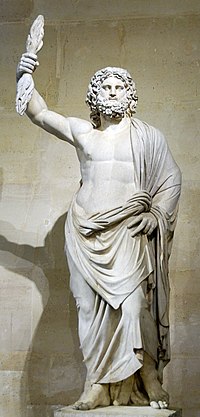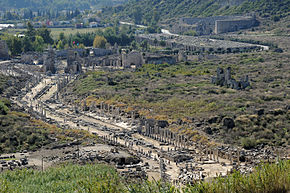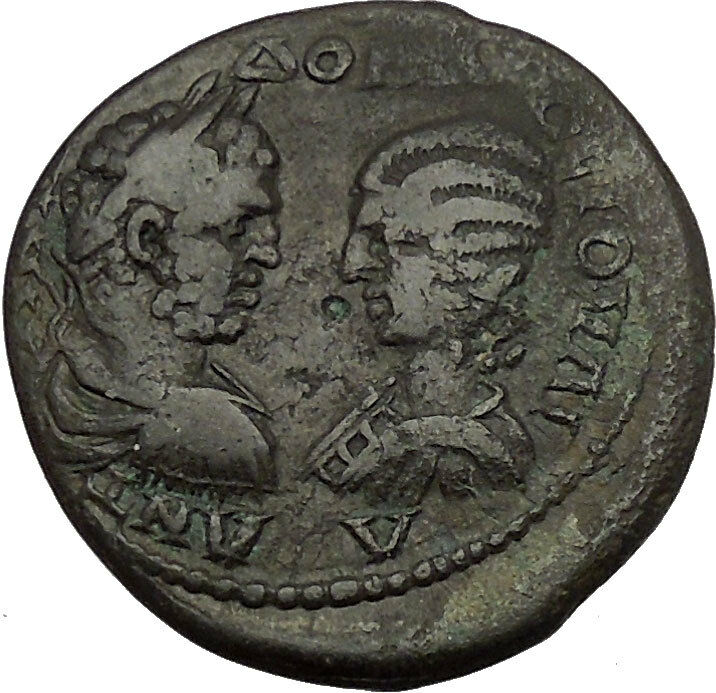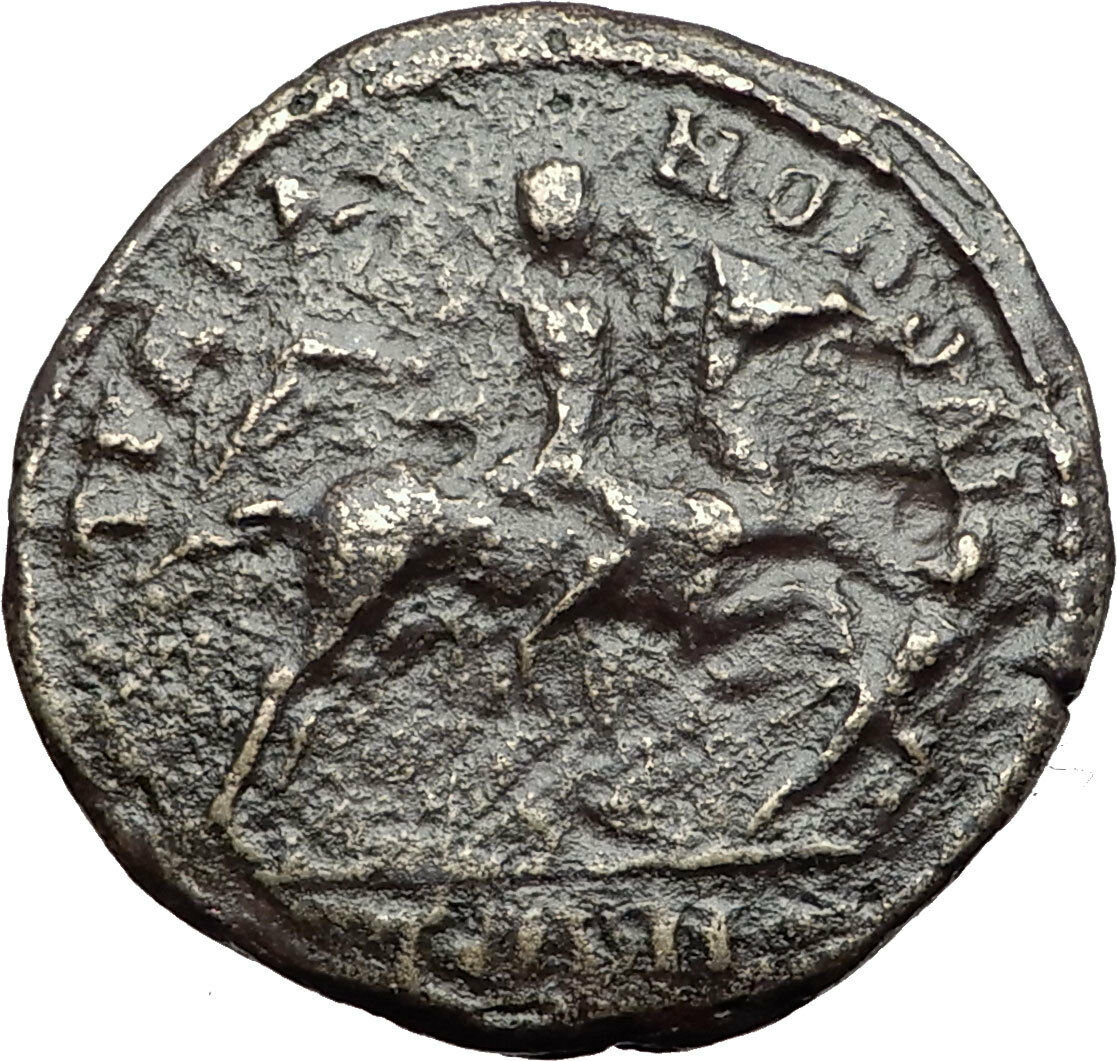|
Salonina – Roman Empress: 253-268 A.D. – Wife of Gallienus
Bronze 29mm (17.17 grams) of Perga (Perge) in Pamphylia mint
Reference: SNG von Aulock 4744; SNG Cop 364.
KOΡNHΛIA CAΛΩNINA CEBA, diademed and draped bust right; I (value) before.
ΠEΡΓAIΩN, Zeus seated right, holding sceptre and patera.
You are bidding on the exact item pictured, provided with a Certificate of Authenticity and Lifetime Guarantee of Authenticity.
 In the ancient Greek religion, Zeus was the “Father of Gods and men” who ruled the Olympians of Mount Olympus as a father ruled the family. He was the god of sky and thunder in Greek mythology. His Roman counterpart is Jupiter and Etruscan counterpart is Tinia. In the ancient Greek religion, Zeus was the “Father of Gods and men” who ruled the Olympians of Mount Olympus as a father ruled the family. He was the god of sky and thunder in Greek mythology. His Roman counterpart is Jupiter and Etruscan counterpart is Tinia.
Zeus was the child of Cronus and Rhea, and the youngest of his siblings. In most traditions he was married to Hera, although, at the oracle of Dodona, his consort was Dione: according to the Iliad, he is the father of Aphrodite by Dione. He is known for his erotic escapades. These resulted in many godly and heroic offspring, including Athena, Apollo and Artemis, Hermes, Persephone (by Demeter), Dionysus, Perseus, Heracles, Helen of Troy, Minos, and the Muses (by Mnemosyne); by Hera, he is usually said to have fathered Ares, Hebe and Hephaestus.
As Walter Burkert points out in his book, Greek Religion, “Even the gods who are not his natural children address him as Father, and all the gods rise in his presence.” For the Greeks, he was the King of the Gods, who oversaw the universe. As Pausanias observed, “That Zeus is king in heaven is a saying common to all men”. In Hesiod’s Theogony Zeus assigns the various gods their roles. In the Homeric Hymns he is referred to as the chieftain of the gods.
His symbols are the thunderbolt, eagle, bull, and oak. In addition to his Indo-European inheritance, the classical “cloud-gatherer” also derives certain iconographic traits from the cultures of the Ancient Near East, such as the scepter. Zeus is frequently depicted by Greek artists in one of two poses: standing, striding forward, with a thunderbolt leveled in his raised right hand, or seated in majesty.
Perga or Perge (Greek: Πέργη Perge, Turkish: Perge) was an ancient Anatolian city in modern Turkey, once the capital of Pamphylia Secunda, now in Antalya province on the southwestern Mediterranean coast of Turkey. Today, it is a large site of ancient ruins 15 kilometres (9.3 mi) east of Antalya on the coastal plain. An acropolis located there dates back to the Bronze Age.

Overview of Perga
History
Perga was an ancient and important city of Pamphylia, between the rivers Catarrhactes and Cestrus (Turkish Aksu Çayı).
A treaty between the Hittite Great King Tudhaliya IV and his vassal, the king of Tarhuntassa, defined the latter’s western border at the city “Parha” and the “Kastaraya River”. The river is assumed to be the classical Cestrus. West of Parha were the “Lukka Lands”. Parha likely spoke a late Luwian dialect like Lycian and that of the neo-Hittite kingdoms.
Perge returns to history as a Pamphylian Greek city, and with Pamphylia came under successive rule by Persians, Athenians, and Persians again. Alexander the Great, after quitting Phaselis, occupied Perge with a part of his army. The road between these two towns is described as long and difficult. Alexander’s rule was followed by the Diadochi empire of the Seleucids, then the Romans.
Perge gained renown for the worship of Artemis, whose temple stood on a hill outside the town, and in whose honour annual festivals were celebrated. The coins of Perge represent both the goddess and her temple.
In 46 A.D., according to the Acts of the Apostles, St. Paul journeyed to Perga, from there continued on to Antiocheia in Pisidia, then returned to Perga where he preached the word of God (Acts 14:25). Then he left the city and went to Attaleia.
As the Cestrus silted up over the late Roman era, Perga declined as a secular city. In the first half of the 4th century, during the reign of Constantine the Great (324-337), Perga became an important centre of Christianity, which soon became the official religion of the Roman Empire. The city retained its status as a Christian centre in the 5th and 6th centuries.
 The agora The agora The stadium The stadium
Ecclesiastical history
St. Paul the Apostle and his, companion St. Barnabas, twice visited Perga as recorded in the biblical book, the Acts of the Apostles, during their first missionary journey, where they “preached the word” before heading for and sailing from Attalia (modern-day Antalya city), 15 kilometres (9.3 mi) to the southwest, to Antioch.
Paul and Barnabas came to Perge during their first missionary journey, but probably stayed there only a short time, and do not seem to have preached there; it was there that John Mark left Paul to return to Jerusalem. On his return from Pisidia, Paul preached at Perge.
St. Matrona of Perge of the 6th century was a female saint known for temporarily cross-dressing to avoid her abusive husband. She also is known for opposing the Monophysite policy of the emperor Anastasios I. Matrona hid in the monastery of St. Bassion as the enuch Babylos. Once revealed, she was sent to a woman’s monastery where she was head of the convent. She was famous for her miraculous gift of healing. She went on to found a nunnery in Constantipole. St Matrona died at the age of 100. Her life was told through a vita prima whose author and exact time period remains a mystery.
The Greek Notitiae episcopatuum mentions the city as metropolis of Pamphylia Secunda until the 13th century. Le Quien gives the names of 11 of its bishops: Epidaurus, present at the Council of Ancyra in 312; Callicles at the First Council of Nicaea in 325; Berenianus, at Constantinople (426); Epiphanius at the Second Council of Ephesus (449), at the First Council of Chalcedon (451), and a signatory of the letter from the bishops of the province to Emperor Leo (458); Hilarianus, at a council at Constantinople in 536; Eulogius, at the Second Council of Constantinople in 553; Apergius, condemned as a Monothelite at the Third Council of Constantinople in 680; John, at the Trullan council in 692; Sisinnius Pastillas about 754 (an iconoclast who was condemned at the Second Council of Nicaea in 787); Constans, at the same council of that condemned his predecessor; John, at the Council of Constantinople of 869-70.
No longer a residential, the bishopric is included in the Catholic Church’s list of titular sees.
Perga remained inhabited until the Seljuks.
Remains
Perga is today an archaeological site and a tourist attraction. Ancient Perge, one of the chief cities of Pamphylia, was situated between the Rivers Catarrhactes (Düden Nehri) and Cestrus (Aksu), 60 stadia (about 11.1 kilometres (6.9 mi)) from the mouth of the latter; the site is in the modern Turkish village of Murtana on the Suridjik sou, a tributary of the Cestrus, formerly in the Ottoman vilayet of Konya. Its ruins include a theatre, a palaestra, a temple of Artemis and two churches. The temple of Artemis was located outside the town.
Another big ancient city in the area is Selge, Pisidia, located about 20km to the northeast.
Notables
- Perga’s most celebrated ancient inhabitant, the mathematician Apollonius (c.262 BC – c.190 BC), lived and worked there. He wrote a series of eight books describing a family of curves known as conic sections, comprising the circle, ellipse, parabola, and hyperbola.
 Pillars of the agora Pillars of the agora Roman theatre Roman theatre Palaestra in front of the Roman baths Palaestra in front of the Roman baths Caldarium in the Roman baths Caldarium in the Roman baths Hellenistic city gate Hellenistic city gate Nymphaeum Nymphaeum
 Julia Cornelia Salonina (d. 268, Mediolanum) was an Augusta, wife of Roman Emperor Gallienus and mother of Valerian II, Saloninus, and Marinianus. Julia Cornelia Salonina (d. 268, Mediolanum) was an Augusta, wife of Roman Emperor Gallienus and mother of Valerian II, Saloninus, and Marinianus.
Julia Cornelia Salonina’s origin is unknown. According to a modern theory, she was born of Greek origin in Bithynia, then part of the province of Bithynia et Pontus, Asia Minor. However, there exists some scepticism on that. She was married to Gallienus about ten years before his accession to the throne. When her husband became joint-emperor with his father Valerian in 253, Cornelia Salonina was named Augusta.
Cornelia was the mother of three princes, Valerian II, Saloninus and Marinianus. Her fate, after the murder of Gallienus, during the siege of Mediolanum in 268, is unknown. It is likely that either her life was spared or the she was executed together with other members of her family, at the orders of the Senate of Rome.
Her name is reported on coins with Latin legend as Cornelia Salonina; however, from the Greek coinage come the names Iulia Cornelia Salonina, Publia Licinia Cornelia Salonina, and Salonina Chrysogona (attribute that means “begotten of gold”).
|





 In the ancient Greek religion, Zeus was the “Father of Gods and men” who ruled the Olympians of Mount Olympus as a father ruled the family. He was the god of sky and thunder in Greek mythology. His Roman counterpart is Jupiter and Etruscan counterpart is Tinia.
In the ancient Greek religion, Zeus was the “Father of Gods and men” who ruled the Olympians of Mount Olympus as a father ruled the family. He was the god of sky and thunder in Greek mythology. His Roman counterpart is Jupiter and Etruscan counterpart is Tinia.
 The agora
The agora The stadium
The stadium Pillars of the agora
Pillars of the agora Roman theatre
Roman theatre Palaestra in front of the Roman baths
Palaestra in front of the Roman baths Caldarium in the Roman baths
Caldarium in the Roman baths Hellenistic city gate
Hellenistic city gate Nymphaeum
Nymphaeum Julia Cornelia Salonina (d. 268, Mediolanum) was an Augusta, wife of Roman Emperor Gallienus and mother of Valerian II, Saloninus, and Marinianus.
Julia Cornelia Salonina (d. 268, Mediolanum) was an Augusta, wife of Roman Emperor Gallienus and mother of Valerian II, Saloninus, and Marinianus.




